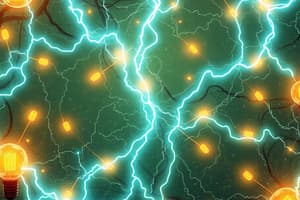Podcast
Questions and Answers
What is the unit of measurement for electric charge?
What is the unit of measurement for electric charge?
- Volt
- Ampere
- Watt
- Coulomb (correct)
What is the direction of electric current flow?
What is the direction of electric current flow?
- From negative to positive terminals (correct)
- From positive to negative terminals
- In a circular motion
- Through the conductor only
What is the formula for calculating electric power?
What is the formula for calculating electric power?
- P = V + I
- P = V / I
- P = V × I (correct)
- P = V - I
Flashcards are hidden until you start studying
Study Notes
Electricity Basics
- Electricity is a form of energy resulting from the movement of charged particles, such as electrons.
- It is a secondary energy source, derived from other energy sources like coal, natural gas, or nuclear reactions.
Electric Charge
- Electric charge is a fundamental property of matter, measured in coulombs (C).
- There are two types of electric charge:
- Positive charge (protons)
- Negative charge (electrons)
Electric Current
- Electric current is the flow of electrons, measured in amperes (A).
- It is the movement of charged particles, typically electrons, through a conductor.
- Current flow is from negative to positive terminals.
Electric Circuit
- An electric circuit is a path through which electric current flows.
- It consists of:
- A power source (e.g., battery)
- A conductor (e.g., wire)
- A load (e.g., light bulb)
- A switch (optional)
Electric Voltage
- Electric voltage is the potential difference between two points, measured in volts (V).
- It is the "pressure" that drives electric current.
- Voltage is the force that pushes electric charge through a circuit.
Resistance
- Resistance is the opposition to electric current, measured in ohms (Ω).
- It depends on the material, length, and cross-sectional area of the conductor.
- Higher resistance reduces electric current.
Ohm's Law
- Ohm's Law states: V = I × R
- Voltage (V) is equal to current (I) multiplied by resistance (R)
- This law relates voltage, current, and resistance in a circuit.
Electric Power
- Electric power is the rate at which electric energy is transferred, measured in watts (W).
- It is calculated by: P = V × I
- Power (P) is equal to voltage (V) multiplied by current (I)
Electricity Basics
- Electricity is a form of energy resulting from the movement of charged particles, such as electrons.
- It is a secondary energy source, derived from other energy sources like coal, natural gas, or nuclear reactions.
Electric Charge
- Electric charge is a fundamental property of matter, measured in coulombs (C).
- There are two types of electric charge:
- Positive charge (protons)
- Negative charge (electrons)
Electric Current
- Electric current is the flow of electrons, measured in amperes (A).
- It is the movement of charged particles, typically electrons, through a conductor.
- Current flow is from negative to positive terminals.
Electric Circuit
- An electric circuit is a path through which electric current flows.
- A circuit consists of:
- A power source (e.g., battery)
- A conductor (e.g., wire)
- A load (e.g., light bulb)
- A switch (optional)
Electric Voltage
- Electric voltage is the potential difference between two points, measured in volts (V).
- It is the "pressure" that drives electric current.
- Voltage is the force that pushes electric charge through a circuit.
Resistance
- Resistance is the opposition to electric current, measured in ohms (Ω).
- It depends on the material, length, and cross-sectional area of the conductor.
- Higher resistance reduces electric current.
Ohm's Law
- Ohm's Law states: V = I × R
- This law relates voltage, current, and resistance in a circuit.
Electric Power
- Electric power is the rate at which electric energy is transferred, measured in watts (W).
- It is calculated by: P = V × I
- Power is the rate of electric energy transfer.
Studying That Suits You
Use AI to generate personalized quizzes and flashcards to suit your learning preferences.




